Rearrangement of Hospital Wards for Socialisation and Communication
VerifiedAdded on 2023/04/20
|15
|4598
|490
AI Summary
This article discusses the importance of socialisation and communication among patients in healthcare facilities and proposes the rearrangement of hospital wards to promote these aspects. It explores the implementation of the ADKAR change management model and the use of the PDSA change management tool. The goal is to improve patient outcomes and create a positive care experience.
Contribute Materials
Your contribution can guide someone’s learning journey. Share your
documents today.
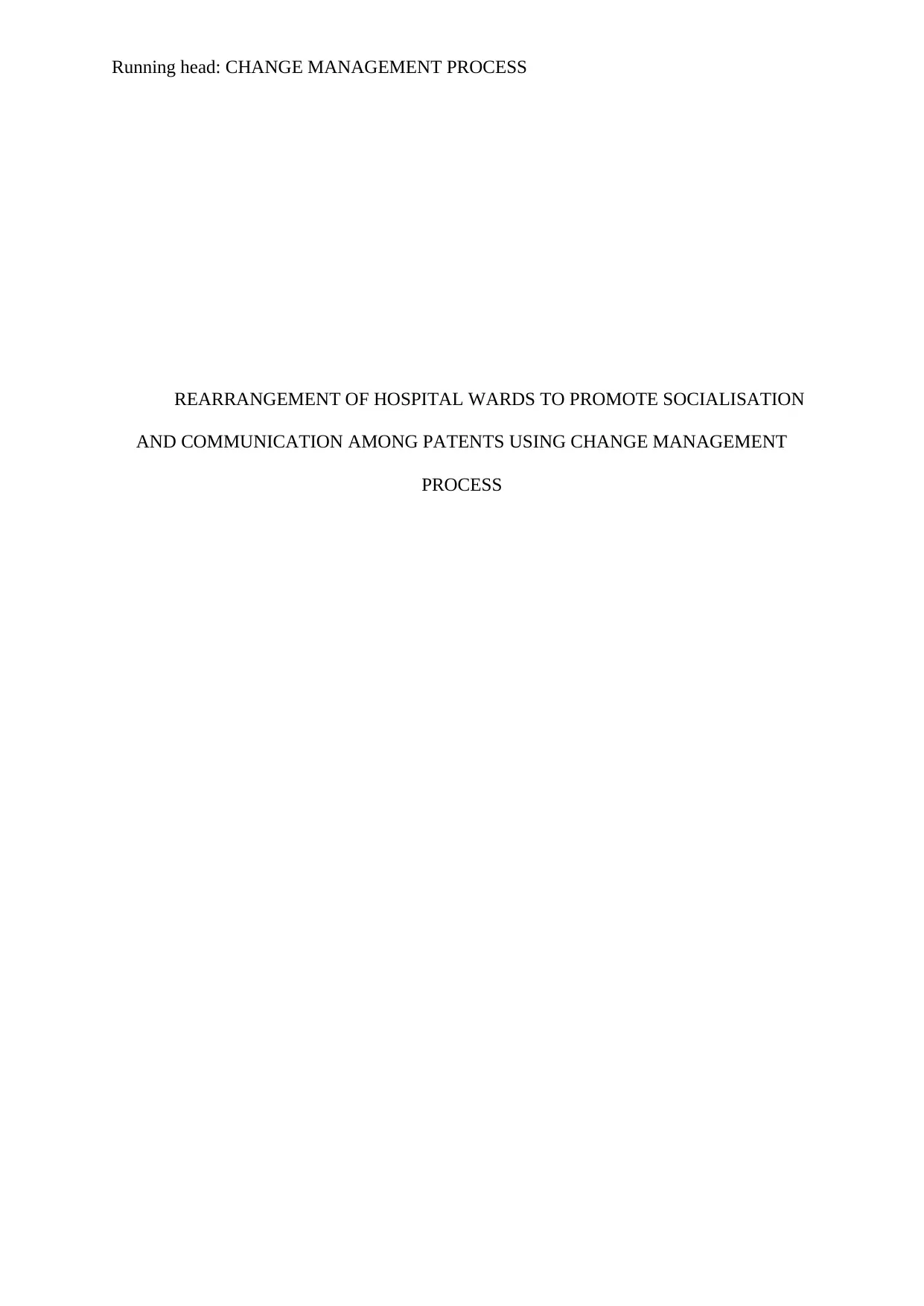
Running head: CHANGE MANAGEMENT PROCESS
REARRANGEMENT OF HOSPITAL WARDS TO PROMOTE SOCIALISATION
AND COMMUNICATION AMONG PATENTS USING CHANGE MANAGEMENT
PROCESS
REARRANGEMENT OF HOSPITAL WARDS TO PROMOTE SOCIALISATION
AND COMMUNICATION AMONG PATENTS USING CHANGE MANAGEMENT
PROCESS
Secure Best Marks with AI Grader
Need help grading? Try our AI Grader for instant feedback on your assignments.
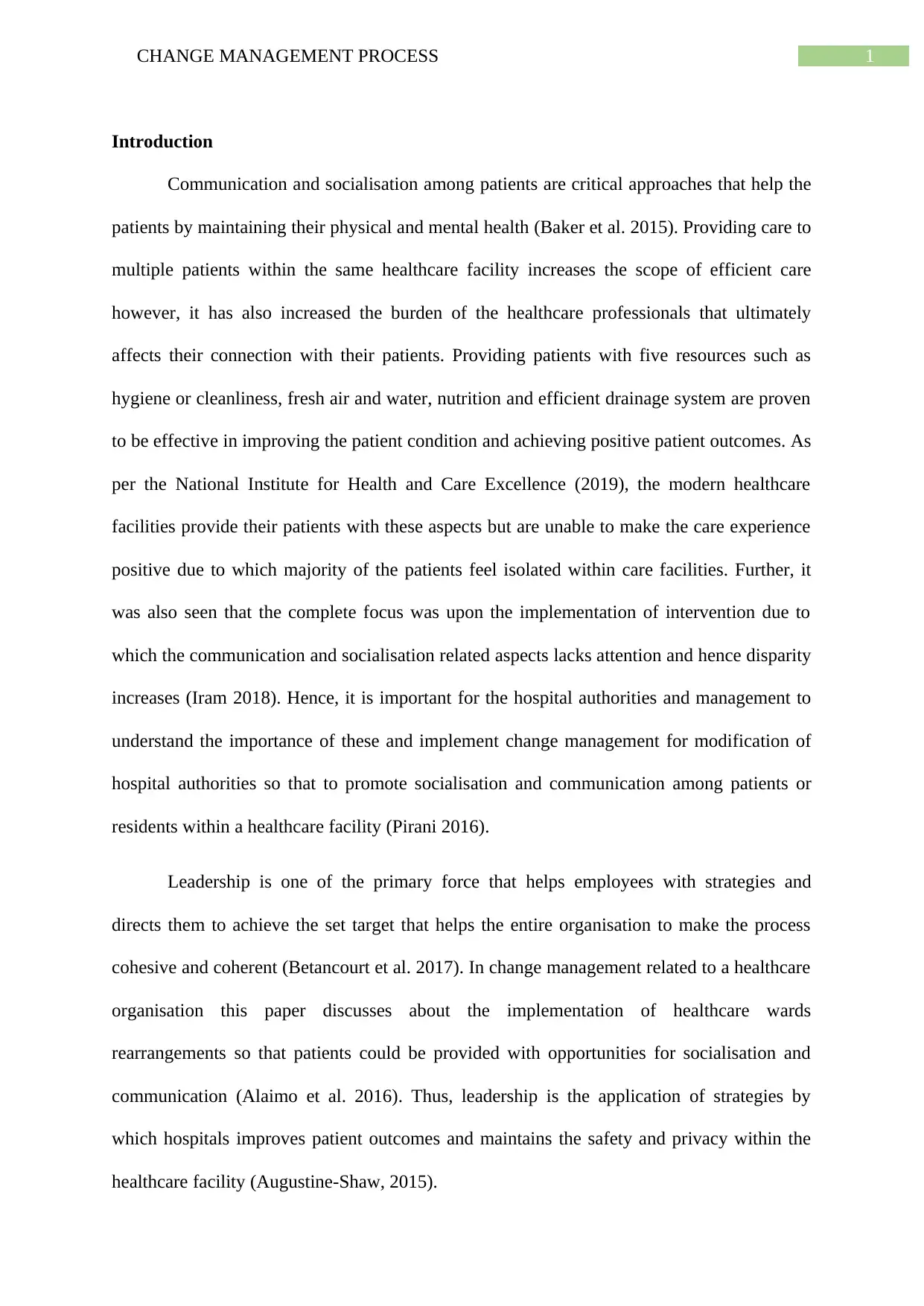
1CHANGE MANAGEMENT PROCESS
Introduction
Communication and socialisation among patients are critical approaches that help the
patients by maintaining their physical and mental health (Baker et al. 2015). Providing care to
multiple patients within the same healthcare facility increases the scope of efficient care
however, it has also increased the burden of the healthcare professionals that ultimately
affects their connection with their patients. Providing patients with five resources such as
hygiene or cleanliness, fresh air and water, nutrition and efficient drainage system are proven
to be effective in improving the patient condition and achieving positive patient outcomes. As
per the National Institute for Health and Care Excellence (2019), the modern healthcare
facilities provide their patients with these aspects but are unable to make the care experience
positive due to which majority of the patients feel isolated within care facilities. Further, it
was also seen that the complete focus was upon the implementation of intervention due to
which the communication and socialisation related aspects lacks attention and hence disparity
increases (Iram 2018). Hence, it is important for the hospital authorities and management to
understand the importance of these and implement change management for modification of
hospital authorities so that to promote socialisation and communication among patients or
residents within a healthcare facility (Pirani 2016).
Leadership is one of the primary force that helps employees with strategies and
directs them to achieve the set target that helps the entire organisation to make the process
cohesive and coherent (Betancourt et al. 2017). In change management related to a healthcare
organisation this paper discusses about the implementation of healthcare wards
rearrangements so that patients could be provided with opportunities for socialisation and
communication (Alaimo et al. 2016). Thus, leadership is the application of strategies by
which hospitals improves patient outcomes and maintains the safety and privacy within the
healthcare facility (Augustine-Shaw, 2015).
Introduction
Communication and socialisation among patients are critical approaches that help the
patients by maintaining their physical and mental health (Baker et al. 2015). Providing care to
multiple patients within the same healthcare facility increases the scope of efficient care
however, it has also increased the burden of the healthcare professionals that ultimately
affects their connection with their patients. Providing patients with five resources such as
hygiene or cleanliness, fresh air and water, nutrition and efficient drainage system are proven
to be effective in improving the patient condition and achieving positive patient outcomes. As
per the National Institute for Health and Care Excellence (2019), the modern healthcare
facilities provide their patients with these aspects but are unable to make the care experience
positive due to which majority of the patients feel isolated within care facilities. Further, it
was also seen that the complete focus was upon the implementation of intervention due to
which the communication and socialisation related aspects lacks attention and hence disparity
increases (Iram 2018). Hence, it is important for the hospital authorities and management to
understand the importance of these and implement change management for modification of
hospital authorities so that to promote socialisation and communication among patients or
residents within a healthcare facility (Pirani 2016).
Leadership is one of the primary force that helps employees with strategies and
directs them to achieve the set target that helps the entire organisation to make the process
cohesive and coherent (Betancourt et al. 2017). In change management related to a healthcare
organisation this paper discusses about the implementation of healthcare wards
rearrangements so that patients could be provided with opportunities for socialisation and
communication (Alaimo et al. 2016). Thus, leadership is the application of strategies by
which hospitals improves patient outcomes and maintains the safety and privacy within the
healthcare facility (Augustine-Shaw, 2015).
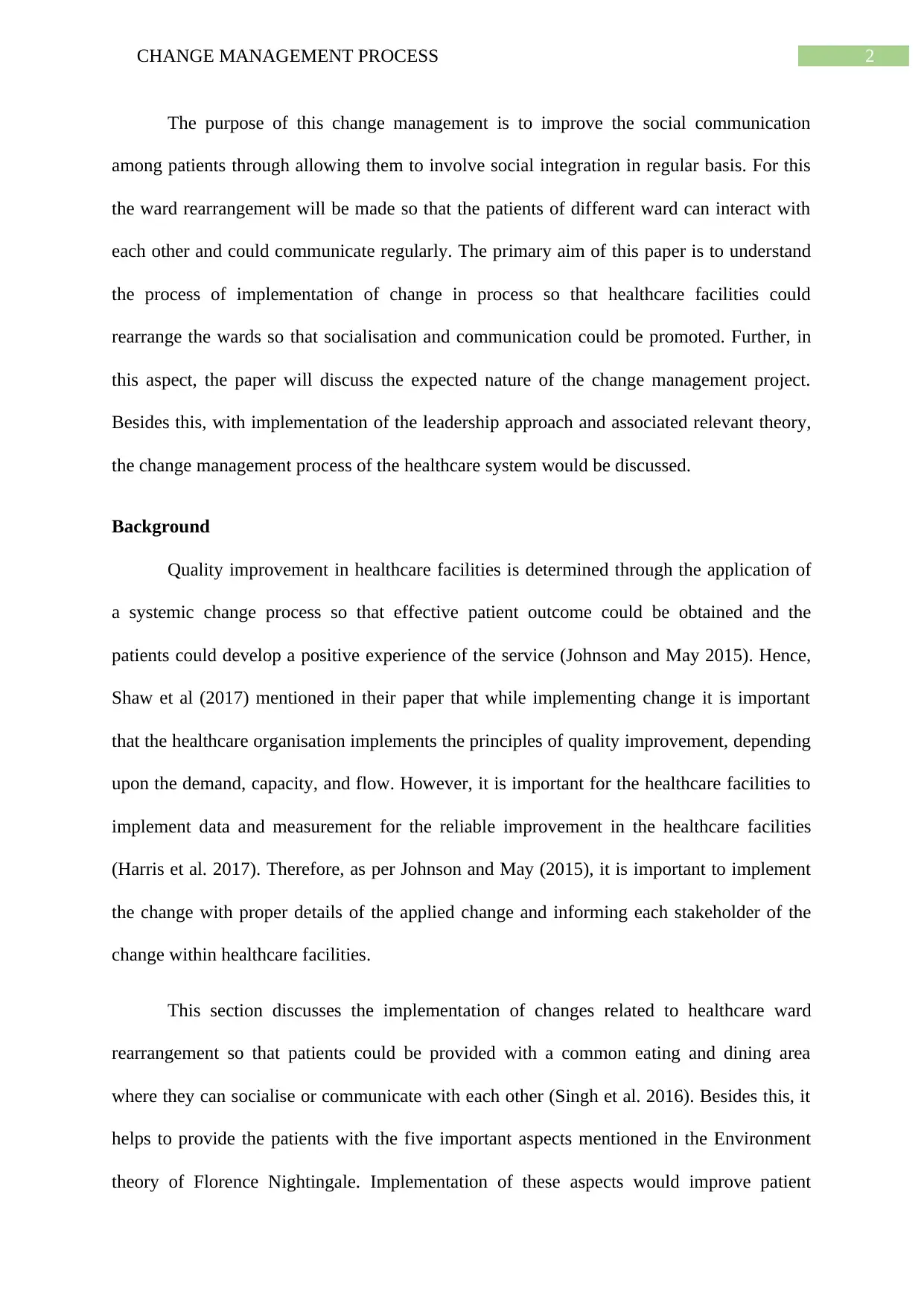
2CHANGE MANAGEMENT PROCESS
The purpose of this change management is to improve the social communication
among patients through allowing them to involve social integration in regular basis. For this
the ward rearrangement will be made so that the patients of different ward can interact with
each other and could communicate regularly. The primary aim of this paper is to understand
the process of implementation of change in process so that healthcare facilities could
rearrange the wards so that socialisation and communication could be promoted. Further, in
this aspect, the paper will discuss the expected nature of the change management project.
Besides this, with implementation of the leadership approach and associated relevant theory,
the change management process of the healthcare system would be discussed.
Background
Quality improvement in healthcare facilities is determined through the application of
a systemic change process so that effective patient outcome could be obtained and the
patients could develop a positive experience of the service (Johnson and May 2015). Hence,
Shaw et al (2017) mentioned in their paper that while implementing change it is important
that the healthcare organisation implements the principles of quality improvement, depending
upon the demand, capacity, and flow. However, it is important for the healthcare facilities to
implement data and measurement for the reliable improvement in the healthcare facilities
(Harris et al. 2017). Therefore, as per Johnson and May (2015), it is important to implement
the change with proper details of the applied change and informing each stakeholder of the
change within healthcare facilities.
This section discusses the implementation of changes related to healthcare ward
rearrangement so that patients could be provided with a common eating and dining area
where they can socialise or communicate with each other (Singh et al. 2016). Besides this, it
helps to provide the patients with the five important aspects mentioned in the Environment
theory of Florence Nightingale. Implementation of these aspects would improve patient
The purpose of this change management is to improve the social communication
among patients through allowing them to involve social integration in regular basis. For this
the ward rearrangement will be made so that the patients of different ward can interact with
each other and could communicate regularly. The primary aim of this paper is to understand
the process of implementation of change in process so that healthcare facilities could
rearrange the wards so that socialisation and communication could be promoted. Further, in
this aspect, the paper will discuss the expected nature of the change management project.
Besides this, with implementation of the leadership approach and associated relevant theory,
the change management process of the healthcare system would be discussed.
Background
Quality improvement in healthcare facilities is determined through the application of
a systemic change process so that effective patient outcome could be obtained and the
patients could develop a positive experience of the service (Johnson and May 2015). Hence,
Shaw et al (2017) mentioned in their paper that while implementing change it is important
that the healthcare organisation implements the principles of quality improvement, depending
upon the demand, capacity, and flow. However, it is important for the healthcare facilities to
implement data and measurement for the reliable improvement in the healthcare facilities
(Harris et al. 2017). Therefore, as per Johnson and May (2015), it is important to implement
the change with proper details of the applied change and informing each stakeholder of the
change within healthcare facilities.
This section discusses the implementation of changes related to healthcare ward
rearrangement so that patients could be provided with a common eating and dining area
where they can socialise or communicate with each other (Singh et al. 2016). Besides this, it
helps to provide the patients with the five important aspects mentioned in the Environment
theory of Florence Nightingale. Implementation of these aspects would improve patient
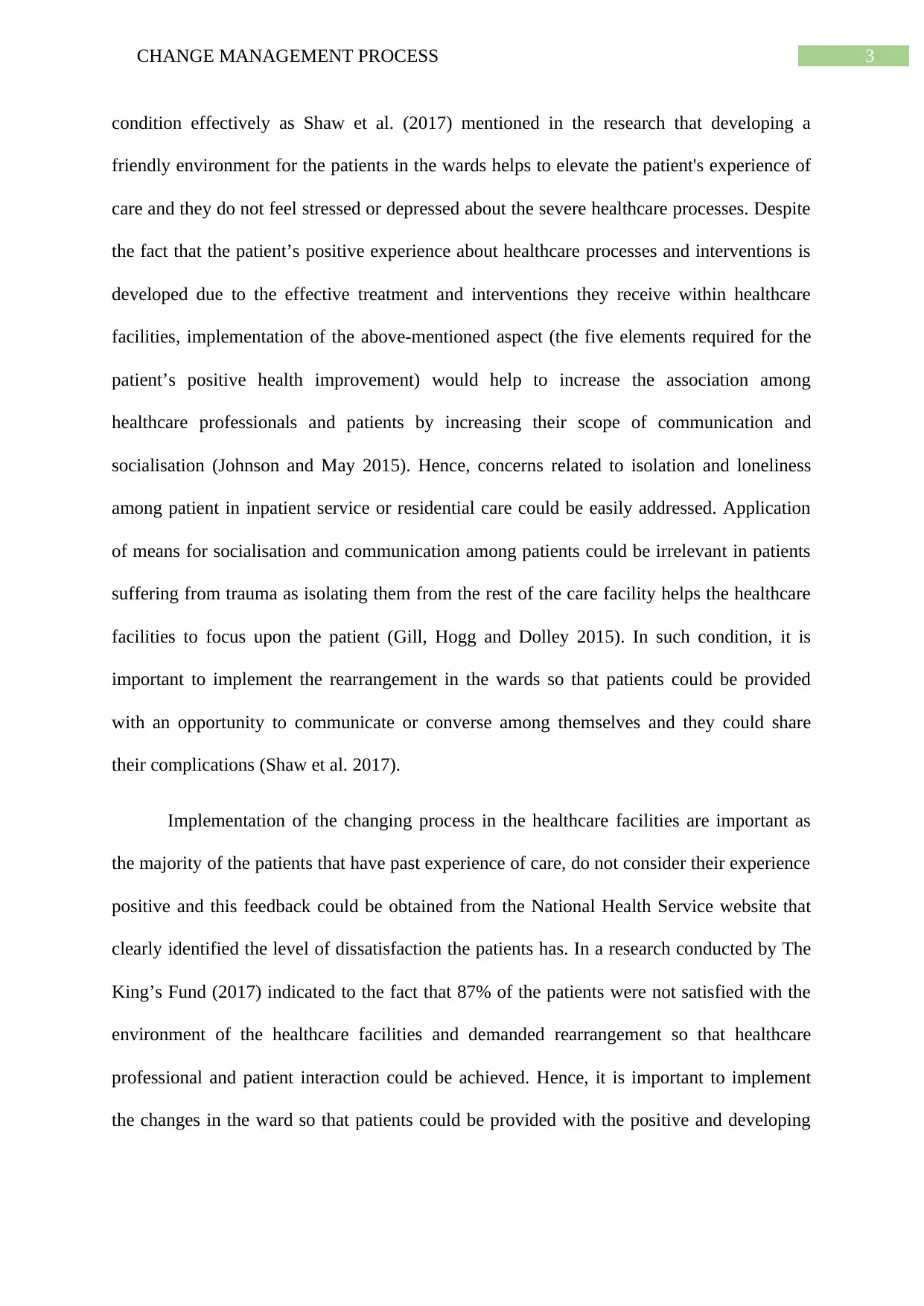
3CHANGE MANAGEMENT PROCESS
condition effectively as Shaw et al. (2017) mentioned in the research that developing a
friendly environment for the patients in the wards helps to elevate the patient's experience of
care and they do not feel stressed or depressed about the severe healthcare processes. Despite
the fact that the patient’s positive experience about healthcare processes and interventions is
developed due to the effective treatment and interventions they receive within healthcare
facilities, implementation of the above-mentioned aspect (the five elements required for the
patient’s positive health improvement) would help to increase the association among
healthcare professionals and patients by increasing their scope of communication and
socialisation (Johnson and May 2015). Hence, concerns related to isolation and loneliness
among patient in inpatient service or residential care could be easily addressed. Application
of means for socialisation and communication among patients could be irrelevant in patients
suffering from trauma as isolating them from the rest of the care facility helps the healthcare
facilities to focus upon the patient (Gill, Hogg and Dolley 2015). In such condition, it is
important to implement the rearrangement in the wards so that patients could be provided
with an opportunity to communicate or converse among themselves and they could share
their complications (Shaw et al. 2017).
Implementation of the changing process in the healthcare facilities are important as
the majority of the patients that have past experience of care, do not consider their experience
positive and this feedback could be obtained from the National Health Service website that
clearly identified the level of dissatisfaction the patients has. In a research conducted by The
King’s Fund (2017) indicated to the fact that 87% of the patients were not satisfied with the
environment of the healthcare facilities and demanded rearrangement so that healthcare
professional and patient interaction could be achieved. Hence, it is important to implement
the changes in the ward so that patients could be provided with the positive and developing
condition effectively as Shaw et al. (2017) mentioned in the research that developing a
friendly environment for the patients in the wards helps to elevate the patient's experience of
care and they do not feel stressed or depressed about the severe healthcare processes. Despite
the fact that the patient’s positive experience about healthcare processes and interventions is
developed due to the effective treatment and interventions they receive within healthcare
facilities, implementation of the above-mentioned aspect (the five elements required for the
patient’s positive health improvement) would help to increase the association among
healthcare professionals and patients by increasing their scope of communication and
socialisation (Johnson and May 2015). Hence, concerns related to isolation and loneliness
among patient in inpatient service or residential care could be easily addressed. Application
of means for socialisation and communication among patients could be irrelevant in patients
suffering from trauma as isolating them from the rest of the care facility helps the healthcare
facilities to focus upon the patient (Gill, Hogg and Dolley 2015). In such condition, it is
important to implement the rearrangement in the wards so that patients could be provided
with an opportunity to communicate or converse among themselves and they could share
their complications (Shaw et al. 2017).
Implementation of the changing process in the healthcare facilities are important as
the majority of the patients that have past experience of care, do not consider their experience
positive and this feedback could be obtained from the National Health Service website that
clearly identified the level of dissatisfaction the patients has. In a research conducted by The
King’s Fund (2017) indicated to the fact that 87% of the patients were not satisfied with the
environment of the healthcare facilities and demanded rearrangement so that healthcare
professional and patient interaction could be achieved. Hence, it is important to implement
the changes in the ward so that patients could be provided with the positive and developing
Secure Best Marks with AI Grader
Need help grading? Try our AI Grader for instant feedback on your assignments.
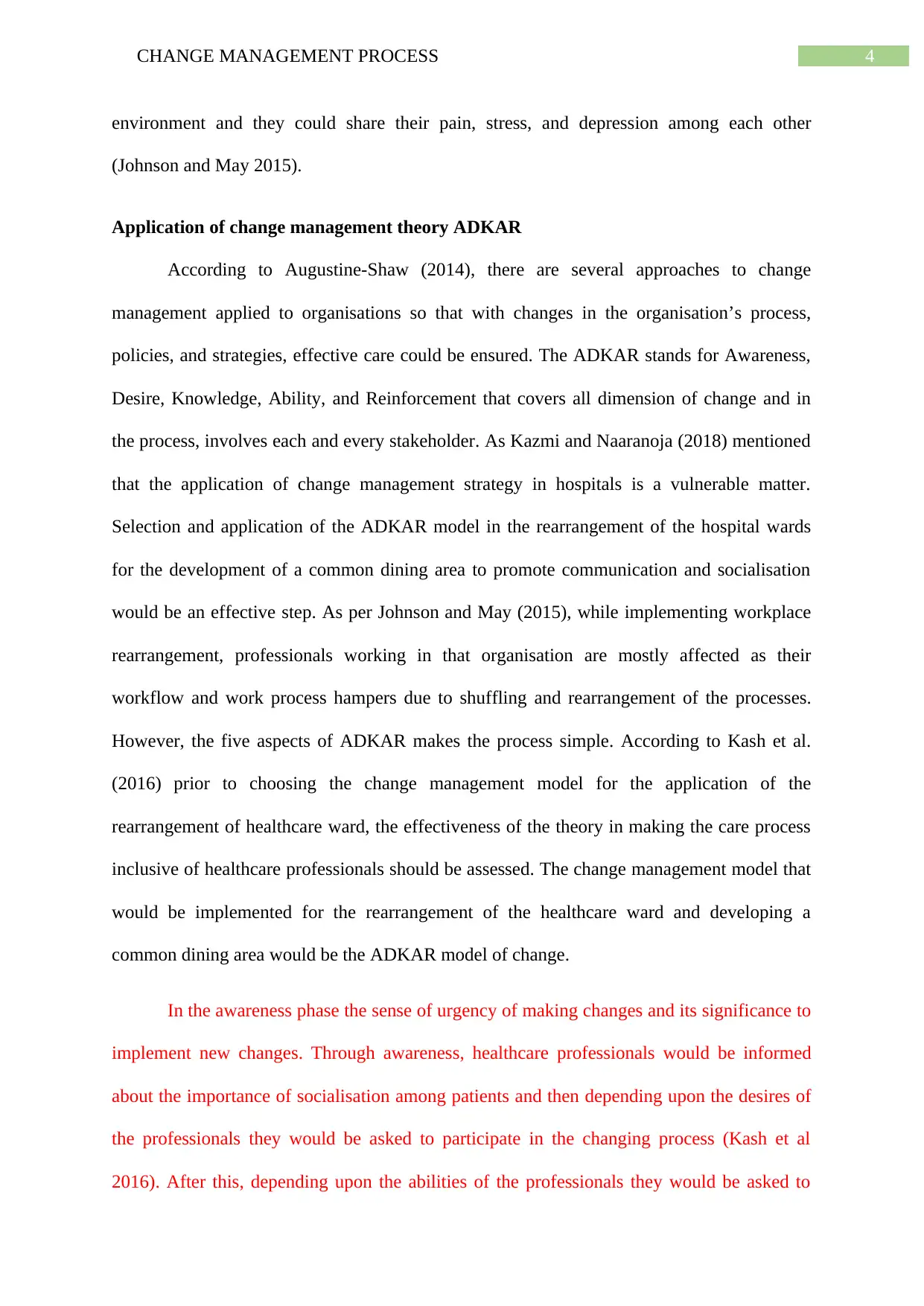
4CHANGE MANAGEMENT PROCESS
environment and they could share their pain, stress, and depression among each other
(Johnson and May 2015).
Application of change management theory ADKAR
According to Augustine-Shaw (2014), there are several approaches to change
management applied to organisations so that with changes in the organisation’s process,
policies, and strategies, effective care could be ensured. The ADKAR stands for Awareness,
Desire, Knowledge, Ability, and Reinforcement that covers all dimension of change and in
the process, involves each and every stakeholder. As Kazmi and Naaranoja (2018) mentioned
that the application of change management strategy in hospitals is a vulnerable matter.
Selection and application of the ADKAR model in the rearrangement of the hospital wards
for the development of a common dining area to promote communication and socialisation
would be an effective step. As per Johnson and May (2015), while implementing workplace
rearrangement, professionals working in that organisation are mostly affected as their
workflow and work process hampers due to shuffling and rearrangement of the processes.
However, the five aspects of ADKAR makes the process simple. According to Kash et al.
(2016) prior to choosing the change management model for the application of the
rearrangement of healthcare ward, the effectiveness of the theory in making the care process
inclusive of healthcare professionals should be assessed. The change management model that
would be implemented for the rearrangement of the healthcare ward and developing a
common dining area would be the ADKAR model of change.
In the awareness phase the sense of urgency of making changes and its significance to
implement new changes. Through awareness, healthcare professionals would be informed
about the importance of socialisation among patients and then depending upon the desires of
the professionals they would be asked to participate in the changing process (Kash et al
2016). After this, depending upon the abilities of the professionals they would be asked to
environment and they could share their pain, stress, and depression among each other
(Johnson and May 2015).
Application of change management theory ADKAR
According to Augustine-Shaw (2014), there are several approaches to change
management applied to organisations so that with changes in the organisation’s process,
policies, and strategies, effective care could be ensured. The ADKAR stands for Awareness,
Desire, Knowledge, Ability, and Reinforcement that covers all dimension of change and in
the process, involves each and every stakeholder. As Kazmi and Naaranoja (2018) mentioned
that the application of change management strategy in hospitals is a vulnerable matter.
Selection and application of the ADKAR model in the rearrangement of the hospital wards
for the development of a common dining area to promote communication and socialisation
would be an effective step. As per Johnson and May (2015), while implementing workplace
rearrangement, professionals working in that organisation are mostly affected as their
workflow and work process hampers due to shuffling and rearrangement of the processes.
However, the five aspects of ADKAR makes the process simple. According to Kash et al.
(2016) prior to choosing the change management model for the application of the
rearrangement of healthcare ward, the effectiveness of the theory in making the care process
inclusive of healthcare professionals should be assessed. The change management model that
would be implemented for the rearrangement of the healthcare ward and developing a
common dining area would be the ADKAR model of change.
In the awareness phase the sense of urgency of making changes and its significance to
implement new changes. Through awareness, healthcare professionals would be informed
about the importance of socialisation among patients and then depending upon the desires of
the professionals they would be asked to participate in the changing process (Kash et al
2016). After this, depending upon the abilities of the professionals they would be asked to
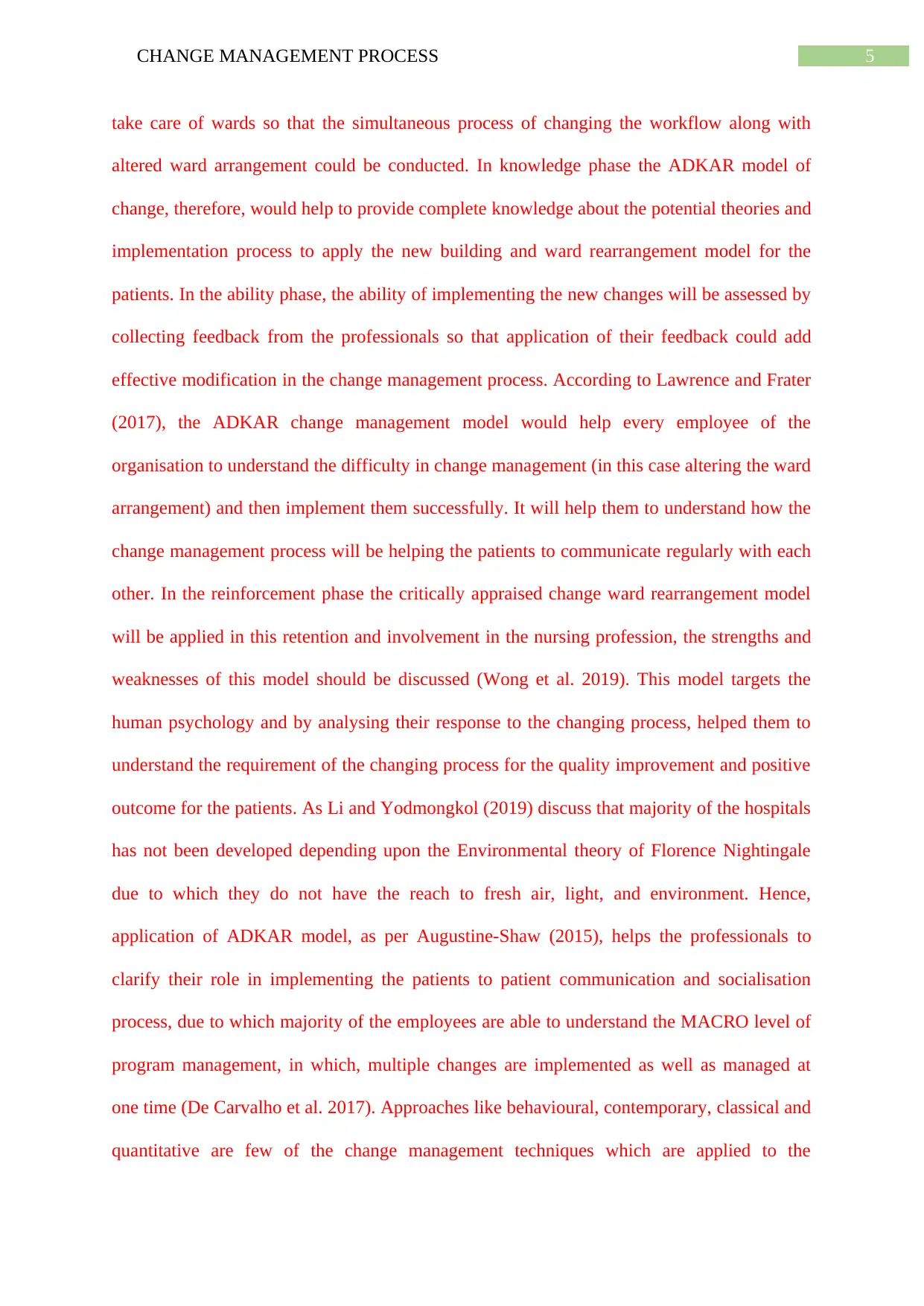
5CHANGE MANAGEMENT PROCESS
take care of wards so that the simultaneous process of changing the workflow along with
altered ward arrangement could be conducted. In knowledge phase the ADKAR model of
change, therefore, would help to provide complete knowledge about the potential theories and
implementation process to apply the new building and ward rearrangement model for the
patients. In the ability phase, the ability of implementing the new changes will be assessed by
collecting feedback from the professionals so that application of their feedback could add
effective modification in the change management process. According to Lawrence and Frater
(2017), the ADKAR change management model would help every employee of the
organisation to understand the difficulty in change management (in this case altering the ward
arrangement) and then implement them successfully. It will help them to understand how the
change management process will be helping the patients to communicate regularly with each
other. In the reinforcement phase the critically appraised change ward rearrangement model
will be applied in this retention and involvement in the nursing profession, the strengths and
weaknesses of this model should be discussed (Wong et al. 2019). This model targets the
human psychology and by analysing their response to the changing process, helped them to
understand the requirement of the changing process for the quality improvement and positive
outcome for the patients. As Li and Yodmongkol (2019) discuss that majority of the hospitals
has not been developed depending upon the Environmental theory of Florence Nightingale
due to which they do not have the reach to fresh air, light, and environment. Hence,
application of ADKAR model, as per Augustine-Shaw (2015), helps the professionals to
clarify their role in implementing the patients to patient communication and socialisation
process, due to which majority of the employees are able to understand the MACRO level of
program management, in which, multiple changes are implemented as well as managed at
one time (De Carvalho et al. 2017). Approaches like behavioural, contemporary, classical and
quantitative are few of the change management techniques which are applied to the
take care of wards so that the simultaneous process of changing the workflow along with
altered ward arrangement could be conducted. In knowledge phase the ADKAR model of
change, therefore, would help to provide complete knowledge about the potential theories and
implementation process to apply the new building and ward rearrangement model for the
patients. In the ability phase, the ability of implementing the new changes will be assessed by
collecting feedback from the professionals so that application of their feedback could add
effective modification in the change management process. According to Lawrence and Frater
(2017), the ADKAR change management model would help every employee of the
organisation to understand the difficulty in change management (in this case altering the ward
arrangement) and then implement them successfully. It will help them to understand how the
change management process will be helping the patients to communicate regularly with each
other. In the reinforcement phase the critically appraised change ward rearrangement model
will be applied in this retention and involvement in the nursing profession, the strengths and
weaknesses of this model should be discussed (Wong et al. 2019). This model targets the
human psychology and by analysing their response to the changing process, helped them to
understand the requirement of the changing process for the quality improvement and positive
outcome for the patients. As Li and Yodmongkol (2019) discuss that majority of the hospitals
has not been developed depending upon the Environmental theory of Florence Nightingale
due to which they do not have the reach to fresh air, light, and environment. Hence,
application of ADKAR model, as per Augustine-Shaw (2015), helps the professionals to
clarify their role in implementing the patients to patient communication and socialisation
process, due to which majority of the employees are able to understand the MACRO level of
program management, in which, multiple changes are implemented as well as managed at
one time (De Carvalho et al. 2017). Approaches like behavioural, contemporary, classical and
quantitative are few of the change management techniques which are applied to the
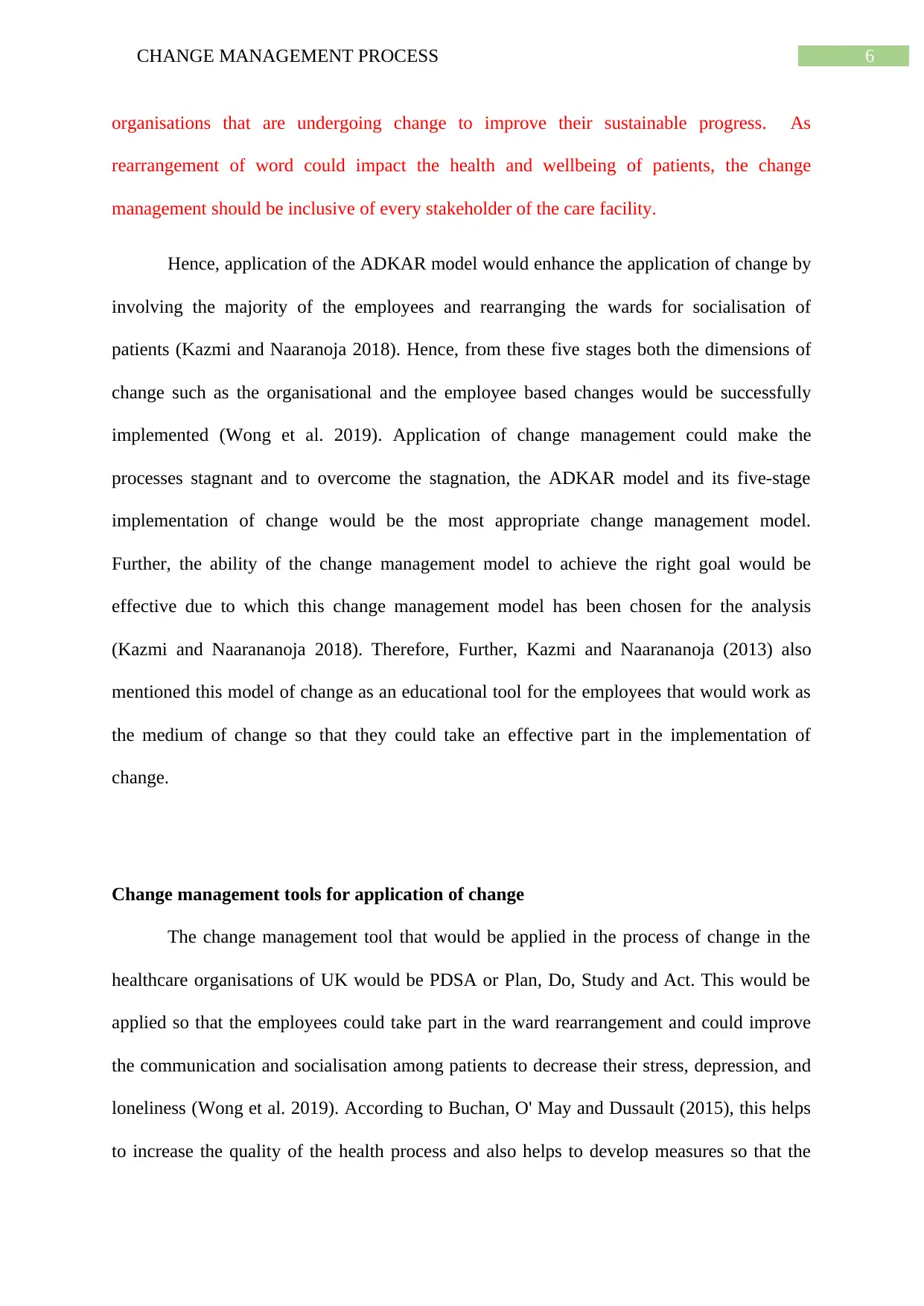
6CHANGE MANAGEMENT PROCESS
organisations that are undergoing change to improve their sustainable progress. As
rearrangement of word could impact the health and wellbeing of patients, the change
management should be inclusive of every stakeholder of the care facility.
Hence, application of the ADKAR model would enhance the application of change by
involving the majority of the employees and rearranging the wards for socialisation of
patients (Kazmi and Naaranoja 2018). Hence, from these five stages both the dimensions of
change such as the organisational and the employee based changes would be successfully
implemented (Wong et al. 2019). Application of change management could make the
processes stagnant and to overcome the stagnation, the ADKAR model and its five-stage
implementation of change would be the most appropriate change management model.
Further, the ability of the change management model to achieve the right goal would be
effective due to which this change management model has been chosen for the analysis
(Kazmi and Naarananoja 2018). Therefore, Further, Kazmi and Naarananoja (2013) also
mentioned this model of change as an educational tool for the employees that would work as
the medium of change so that they could take an effective part in the implementation of
change.
Change management tools for application of change
The change management tool that would be applied in the process of change in the
healthcare organisations of UK would be PDSA or Plan, Do, Study and Act. This would be
applied so that the employees could take part in the ward rearrangement and could improve
the communication and socialisation among patients to decrease their stress, depression, and
loneliness (Wong et al. 2019). According to Buchan, O' May and Dussault (2015), this helps
to increase the quality of the health process and also helps to develop measures so that the
organisations that are undergoing change to improve their sustainable progress. As
rearrangement of word could impact the health and wellbeing of patients, the change
management should be inclusive of every stakeholder of the care facility.
Hence, application of the ADKAR model would enhance the application of change by
involving the majority of the employees and rearranging the wards for socialisation of
patients (Kazmi and Naaranoja 2018). Hence, from these five stages both the dimensions of
change such as the organisational and the employee based changes would be successfully
implemented (Wong et al. 2019). Application of change management could make the
processes stagnant and to overcome the stagnation, the ADKAR model and its five-stage
implementation of change would be the most appropriate change management model.
Further, the ability of the change management model to achieve the right goal would be
effective due to which this change management model has been chosen for the analysis
(Kazmi and Naarananoja 2018). Therefore, Further, Kazmi and Naarananoja (2013) also
mentioned this model of change as an educational tool for the employees that would work as
the medium of change so that they could take an effective part in the implementation of
change.
Change management tools for application of change
The change management tool that would be applied in the process of change in the
healthcare organisations of UK would be PDSA or Plan, Do, Study and Act. This would be
applied so that the employees could take part in the ward rearrangement and could improve
the communication and socialisation among patients to decrease their stress, depression, and
loneliness (Wong et al. 2019). According to Buchan, O' May and Dussault (2015), this helps
to increase the quality of the health process and also helps to develop measures so that the
Paraphrase This Document
Need a fresh take? Get an instant paraphrase of this document with our AI Paraphraser
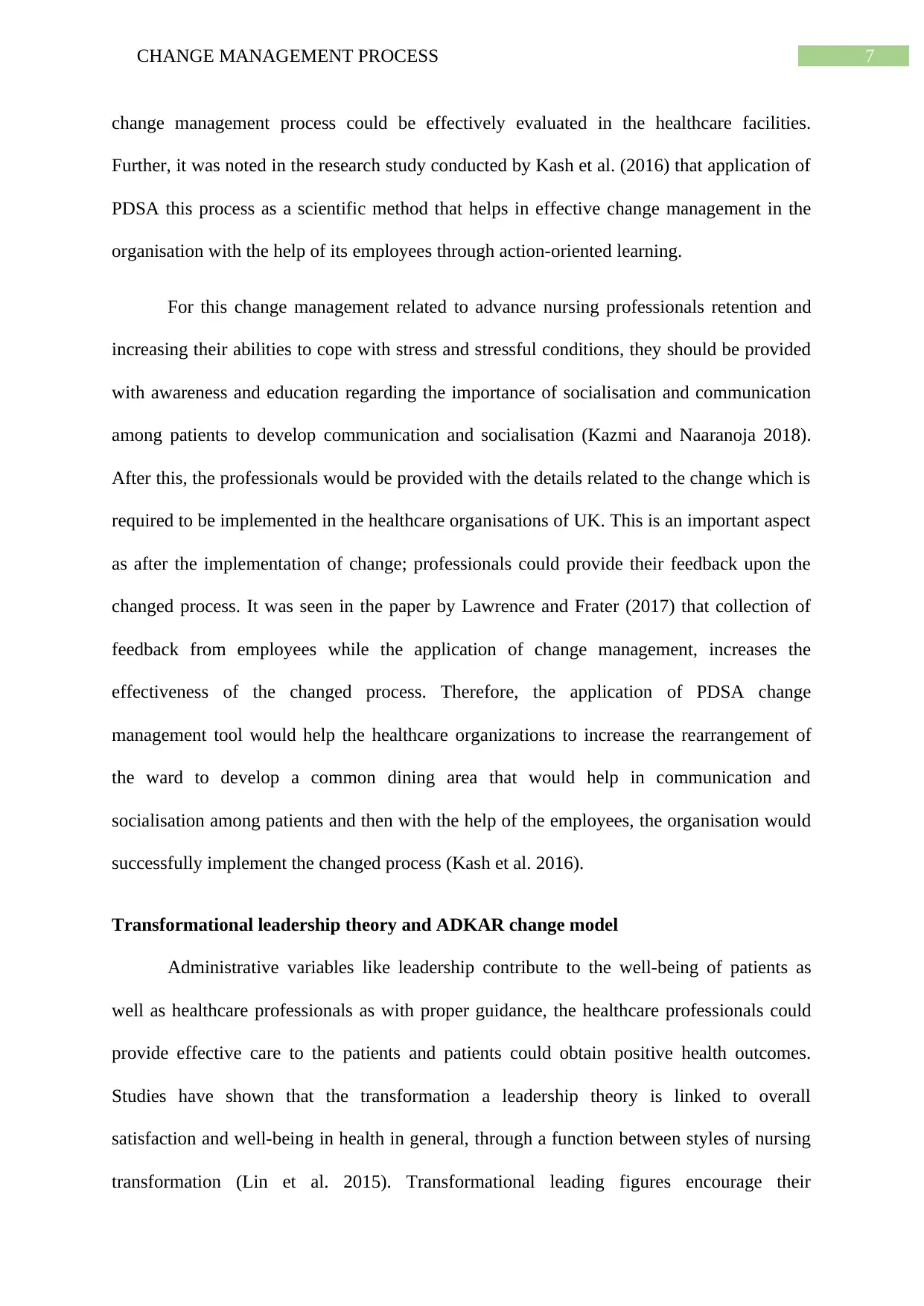
7CHANGE MANAGEMENT PROCESS
change management process could be effectively evaluated in the healthcare facilities.
Further, it was noted in the research study conducted by Kash et al. (2016) that application of
PDSA this process as a scientific method that helps in effective change management in the
organisation with the help of its employees through action-oriented learning.
For this change management related to advance nursing professionals retention and
increasing their abilities to cope with stress and stressful conditions, they should be provided
with awareness and education regarding the importance of socialisation and communication
among patients to develop communication and socialisation (Kazmi and Naaranoja 2018).
After this, the professionals would be provided with the details related to the change which is
required to be implemented in the healthcare organisations of UK. This is an important aspect
as after the implementation of change; professionals could provide their feedback upon the
changed process. It was seen in the paper by Lawrence and Frater (2017) that collection of
feedback from employees while the application of change management, increases the
effectiveness of the changed process. Therefore, the application of PDSA change
management tool would help the healthcare organizations to increase the rearrangement of
the ward to develop a common dining area that would help in communication and
socialisation among patients and then with the help of the employees, the organisation would
successfully implement the changed process (Kash et al. 2016).
Transformational leadership theory and ADKAR change model
Administrative variables like leadership contribute to the well-being of patients as
well as healthcare professionals as with proper guidance, the healthcare professionals could
provide effective care to the patients and patients could obtain positive health outcomes.
Studies have shown that the transformation a leadership theory is linked to overall
satisfaction and well-being in health in general, through a function between styles of nursing
transformation (Lin et al. 2015). Transformational leading figures encourage their
change management process could be effectively evaluated in the healthcare facilities.
Further, it was noted in the research study conducted by Kash et al. (2016) that application of
PDSA this process as a scientific method that helps in effective change management in the
organisation with the help of its employees through action-oriented learning.
For this change management related to advance nursing professionals retention and
increasing their abilities to cope with stress and stressful conditions, they should be provided
with awareness and education regarding the importance of socialisation and communication
among patients to develop communication and socialisation (Kazmi and Naaranoja 2018).
After this, the professionals would be provided with the details related to the change which is
required to be implemented in the healthcare organisations of UK. This is an important aspect
as after the implementation of change; professionals could provide their feedback upon the
changed process. It was seen in the paper by Lawrence and Frater (2017) that collection of
feedback from employees while the application of change management, increases the
effectiveness of the changed process. Therefore, the application of PDSA change
management tool would help the healthcare organizations to increase the rearrangement of
the ward to develop a common dining area that would help in communication and
socialisation among patients and then with the help of the employees, the organisation would
successfully implement the changed process (Kash et al. 2016).
Transformational leadership theory and ADKAR change model
Administrative variables like leadership contribute to the well-being of patients as
well as healthcare professionals as with proper guidance, the healthcare professionals could
provide effective care to the patients and patients could obtain positive health outcomes.
Studies have shown that the transformation a leadership theory is linked to overall
satisfaction and well-being in health in general, through a function between styles of nursing
transformation (Lin et al. 2015). Transformational leading figures encourage their
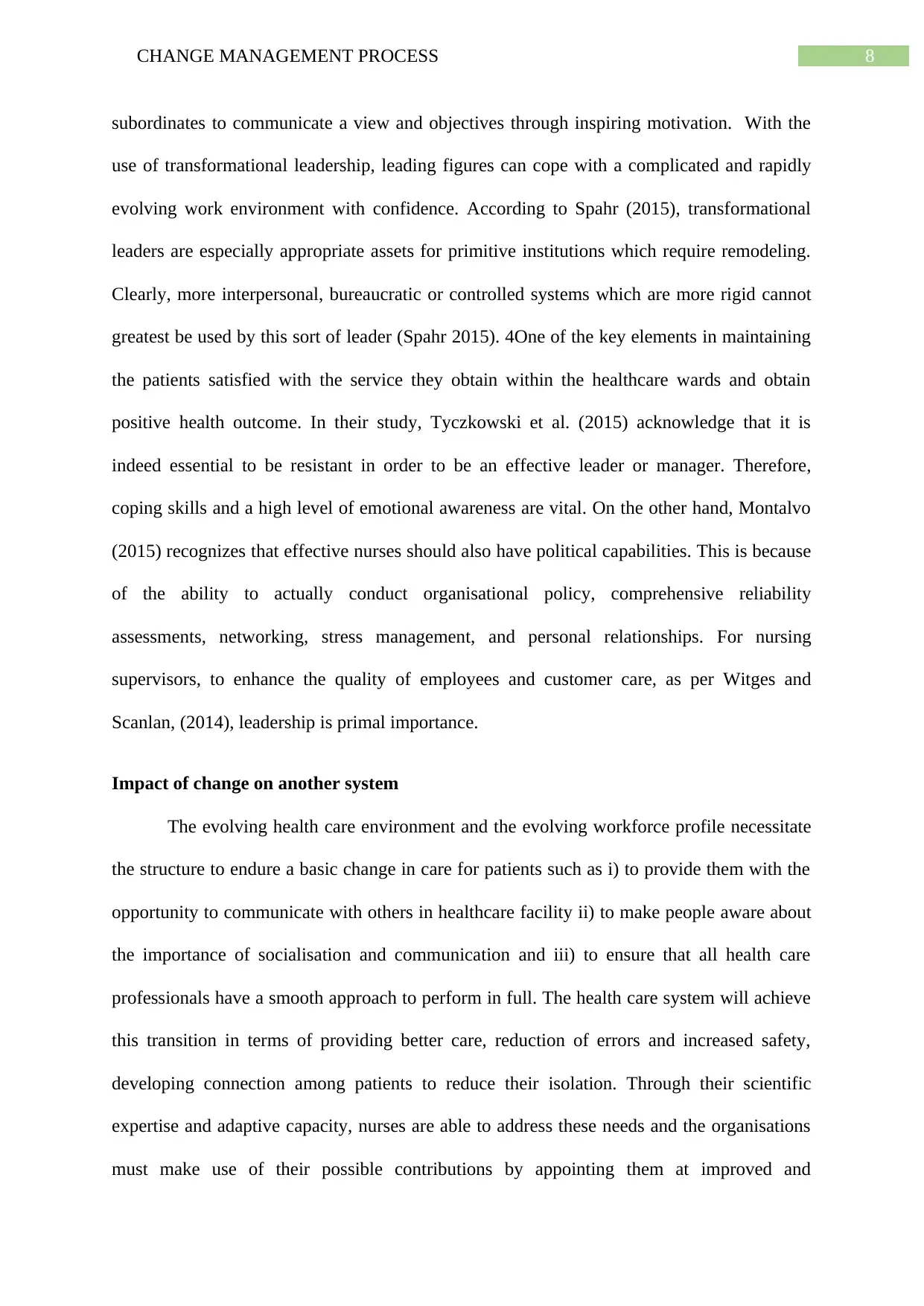
8CHANGE MANAGEMENT PROCESS
subordinates to communicate a view and objectives through inspiring motivation. With the
use of transformational leadership, leading figures can cope with a complicated and rapidly
evolving work environment with confidence. According to Spahr (2015), transformational
leaders are especially appropriate assets for primitive institutions which require remodeling.
Clearly, more interpersonal, bureaucratic or controlled systems which are more rigid cannot
greatest be used by this sort of leader (Spahr 2015). 4One of the key elements in maintaining
the patients satisfied with the service they obtain within the healthcare wards and obtain
positive health outcome. In their study, Tyczkowski et al. (2015) acknowledge that it is
indeed essential to be resistant in order to be an effective leader or manager. Therefore,
coping skills and a high level of emotional awareness are vital. On the other hand, Montalvo
(2015) recognizes that effective nurses should also have political capabilities. This is because
of the ability to actually conduct organisational policy, comprehensive reliability
assessments, networking, stress management, and personal relationships. For nursing
supervisors, to enhance the quality of employees and customer care, as per Witges and
Scanlan, (2014), leadership is primal importance.
Impact of change on another system
The evolving health care environment and the evolving workforce profile necessitate
the structure to endure a basic change in care for patients such as i) to provide them with the
opportunity to communicate with others in healthcare facility ii) to make people aware about
the importance of socialisation and communication and iii) to ensure that all health care
professionals have a smooth approach to perform in full. The health care system will achieve
this transition in terms of providing better care, reduction of errors and increased safety,
developing connection among patients to reduce their isolation. Through their scientific
expertise and adaptive capacity, nurses are able to address these needs and the organisations
must make use of their possible contributions by appointing them at improved and
subordinates to communicate a view and objectives through inspiring motivation. With the
use of transformational leadership, leading figures can cope with a complicated and rapidly
evolving work environment with confidence. According to Spahr (2015), transformational
leaders are especially appropriate assets for primitive institutions which require remodeling.
Clearly, more interpersonal, bureaucratic or controlled systems which are more rigid cannot
greatest be used by this sort of leader (Spahr 2015). 4One of the key elements in maintaining
the patients satisfied with the service they obtain within the healthcare wards and obtain
positive health outcome. In their study, Tyczkowski et al. (2015) acknowledge that it is
indeed essential to be resistant in order to be an effective leader or manager. Therefore,
coping skills and a high level of emotional awareness are vital. On the other hand, Montalvo
(2015) recognizes that effective nurses should also have political capabilities. This is because
of the ability to actually conduct organisational policy, comprehensive reliability
assessments, networking, stress management, and personal relationships. For nursing
supervisors, to enhance the quality of employees and customer care, as per Witges and
Scanlan, (2014), leadership is primal importance.
Impact of change on another system
The evolving health care environment and the evolving workforce profile necessitate
the structure to endure a basic change in care for patients such as i) to provide them with the
opportunity to communicate with others in healthcare facility ii) to make people aware about
the importance of socialisation and communication and iii) to ensure that all health care
professionals have a smooth approach to perform in full. The health care system will achieve
this transition in terms of providing better care, reduction of errors and increased safety,
developing connection among patients to reduce their isolation. Through their scientific
expertise and adaptive capacity, nurses are able to address these needs and the organisations
must make use of their possible contributions by appointing them at improved and
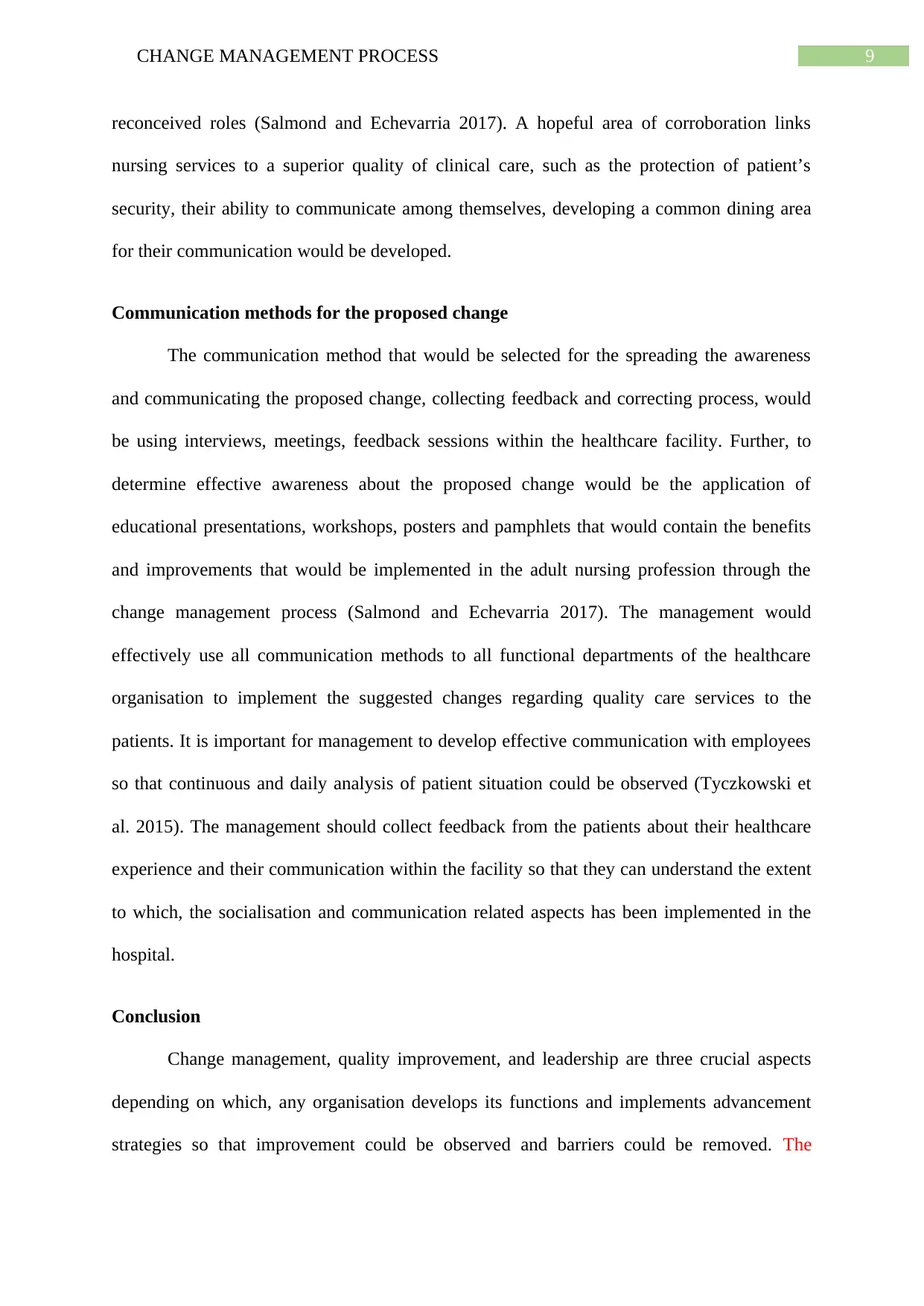
9CHANGE MANAGEMENT PROCESS
reconceived roles (Salmond and Echevarria 2017). A hopeful area of corroboration links
nursing services to a superior quality of clinical care, such as the protection of patient’s
security, their ability to communicate among themselves, developing a common dining area
for their communication would be developed.
Communication methods for the proposed change
The communication method that would be selected for the spreading the awareness
and communicating the proposed change, collecting feedback and correcting process, would
be using interviews, meetings, feedback sessions within the healthcare facility. Further, to
determine effective awareness about the proposed change would be the application of
educational presentations, workshops, posters and pamphlets that would contain the benefits
and improvements that would be implemented in the adult nursing profession through the
change management process (Salmond and Echevarria 2017). The management would
effectively use all communication methods to all functional departments of the healthcare
organisation to implement the suggested changes regarding quality care services to the
patients. It is important for management to develop effective communication with employees
so that continuous and daily analysis of patient situation could be observed (Tyczkowski et
al. 2015). The management should collect feedback from the patients about their healthcare
experience and their communication within the facility so that they can understand the extent
to which, the socialisation and communication related aspects has been implemented in the
hospital.
Conclusion
Change management, quality improvement, and leadership are three crucial aspects
depending on which, any organisation develops its functions and implements advancement
strategies so that improvement could be observed and barriers could be removed. The
reconceived roles (Salmond and Echevarria 2017). A hopeful area of corroboration links
nursing services to a superior quality of clinical care, such as the protection of patient’s
security, their ability to communicate among themselves, developing a common dining area
for their communication would be developed.
Communication methods for the proposed change
The communication method that would be selected for the spreading the awareness
and communicating the proposed change, collecting feedback and correcting process, would
be using interviews, meetings, feedback sessions within the healthcare facility. Further, to
determine effective awareness about the proposed change would be the application of
educational presentations, workshops, posters and pamphlets that would contain the benefits
and improvements that would be implemented in the adult nursing profession through the
change management process (Salmond and Echevarria 2017). The management would
effectively use all communication methods to all functional departments of the healthcare
organisation to implement the suggested changes regarding quality care services to the
patients. It is important for management to develop effective communication with employees
so that continuous and daily analysis of patient situation could be observed (Tyczkowski et
al. 2015). The management should collect feedback from the patients about their healthcare
experience and their communication within the facility so that they can understand the extent
to which, the socialisation and communication related aspects has been implemented in the
hospital.
Conclusion
Change management, quality improvement, and leadership are three crucial aspects
depending on which, any organisation develops its functions and implements advancement
strategies so that improvement could be observed and barriers could be removed. The
Secure Best Marks with AI Grader
Need help grading? Try our AI Grader for instant feedback on your assignments.
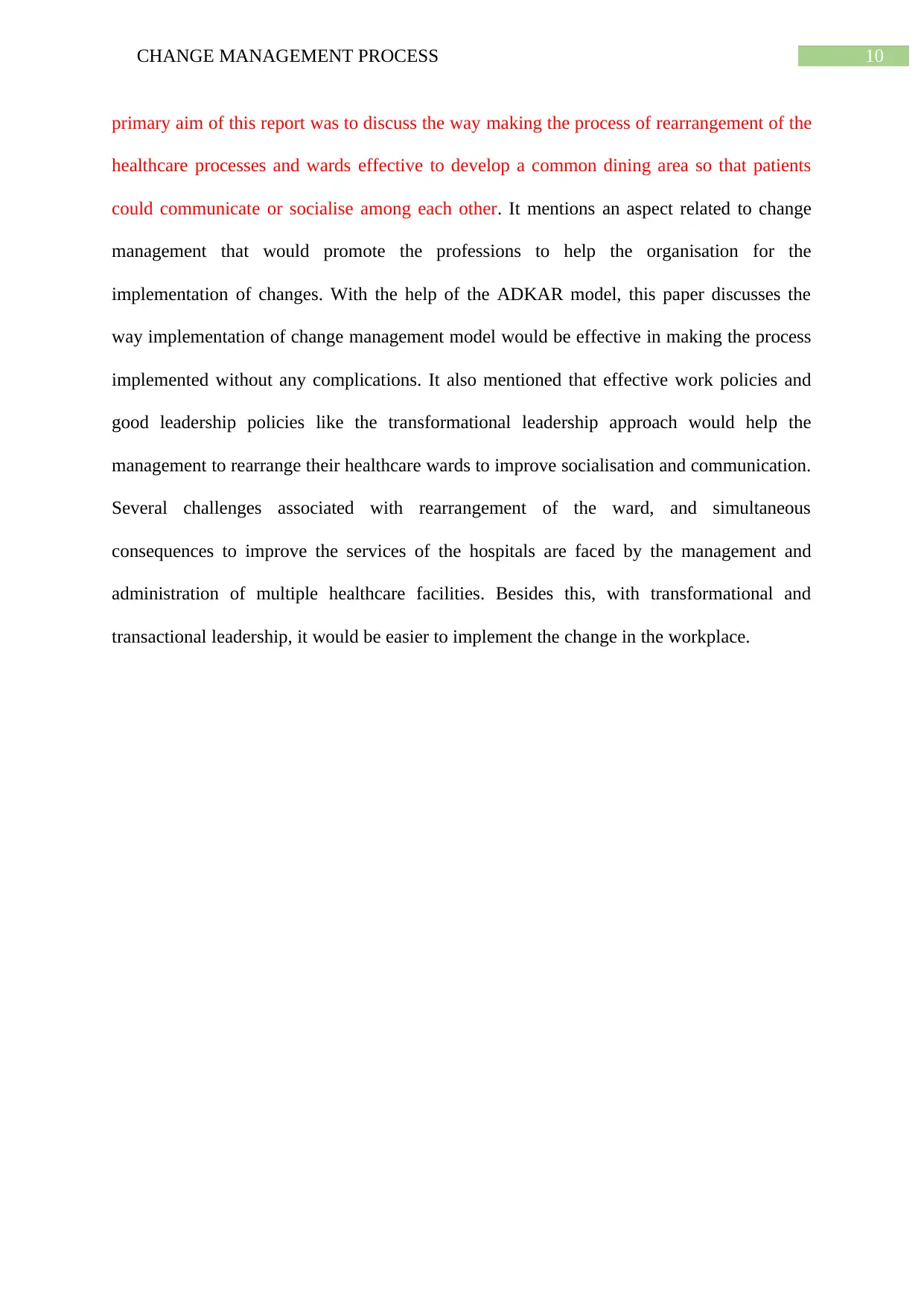
10CHANGE MANAGEMENT PROCESS
primary aim of this report was to discuss the way making the process of rearrangement of the
healthcare processes and wards effective to develop a common dining area so that patients
could communicate or socialise among each other. It mentions an aspect related to change
management that would promote the professions to help the organisation for the
implementation of changes. With the help of the ADKAR model, this paper discusses the
way implementation of change management model would be effective in making the process
implemented without any complications. It also mentioned that effective work policies and
good leadership policies like the transformational leadership approach would help the
management to rearrange their healthcare wards to improve socialisation and communication.
Several challenges associated with rearrangement of the ward, and simultaneous
consequences to improve the services of the hospitals are faced by the management and
administration of multiple healthcare facilities. Besides this, with transformational and
transactional leadership, it would be easier to implement the change in the workplace.
primary aim of this report was to discuss the way making the process of rearrangement of the
healthcare processes and wards effective to develop a common dining area so that patients
could communicate or socialise among each other. It mentions an aspect related to change
management that would promote the professions to help the organisation for the
implementation of changes. With the help of the ADKAR model, this paper discusses the
way implementation of change management model would be effective in making the process
implemented without any complications. It also mentioned that effective work policies and
good leadership policies like the transformational leadership approach would help the
management to rearrange their healthcare wards to improve socialisation and communication.
Several challenges associated with rearrangement of the ward, and simultaneous
consequences to improve the services of the hospitals are faced by the management and
administration of multiple healthcare facilities. Besides this, with transformational and
transactional leadership, it would be easier to implement the change in the workplace.
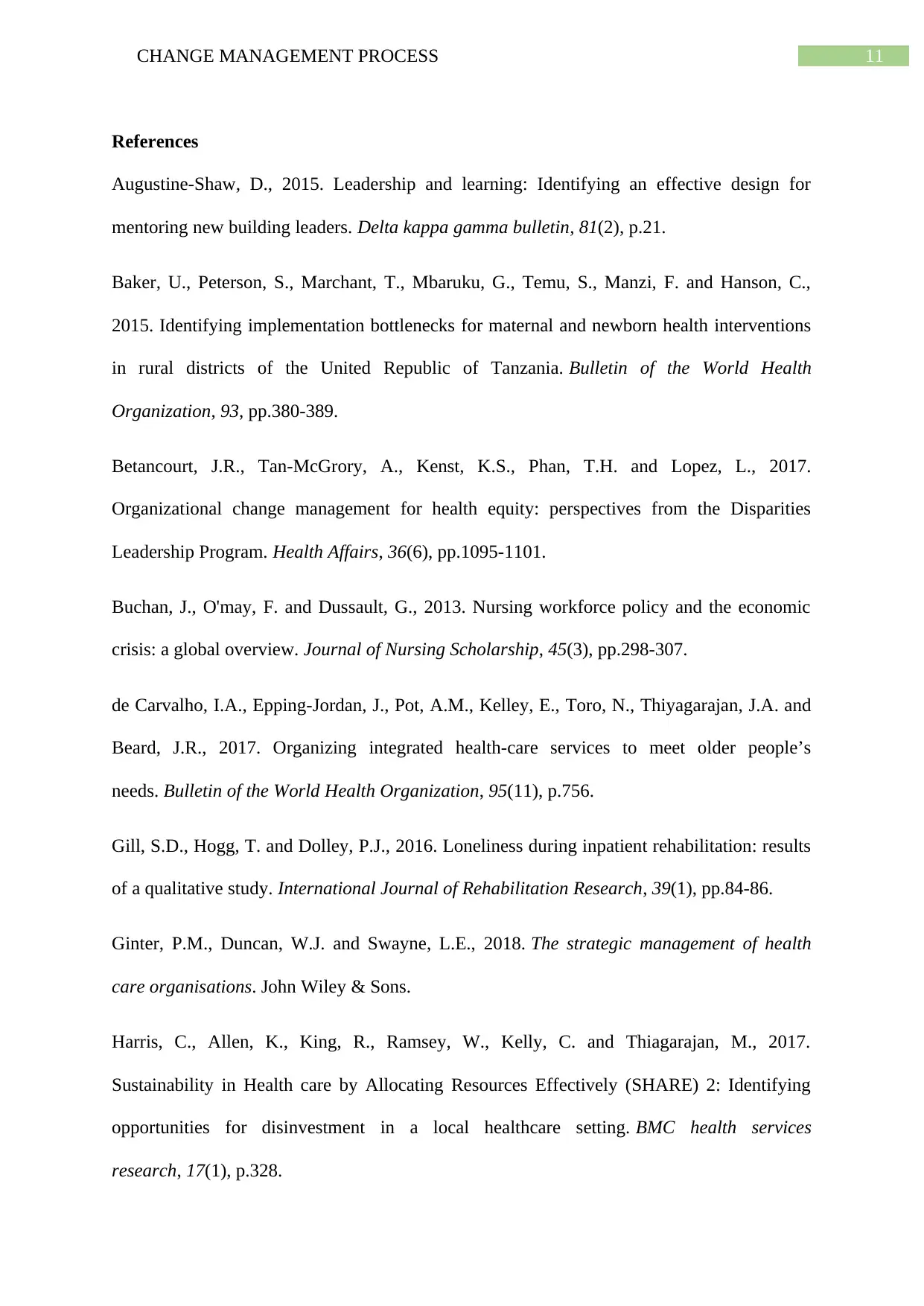
11CHANGE MANAGEMENT PROCESS
References
Augustine-Shaw, D., 2015. Leadership and learning: Identifying an effective design for
mentoring new building leaders. Delta kappa gamma bulletin, 81(2), p.21.
Baker, U., Peterson, S., Marchant, T., Mbaruku, G., Temu, S., Manzi, F. and Hanson, C.,
2015. Identifying implementation bottlenecks for maternal and newborn health interventions
in rural districts of the United Republic of Tanzania. Bulletin of the World Health
Organization, 93, pp.380-389.
Betancourt, J.R., Tan-McGrory, A., Kenst, K.S., Phan, T.H. and Lopez, L., 2017.
Organizational change management for health equity: perspectives from the Disparities
Leadership Program. Health Affairs, 36(6), pp.1095-1101.
Buchan, J., O'may, F. and Dussault, G., 2013. Nursing workforce policy and the economic
crisis: a global overview. Journal of Nursing Scholarship, 45(3), pp.298-307.
de Carvalho, I.A., Epping-Jordan, J., Pot, A.M., Kelley, E., Toro, N., Thiyagarajan, J.A. and
Beard, J.R., 2017. Organizing integrated health-care services to meet older people’s
needs. Bulletin of the World Health Organization, 95(11), p.756.
Gill, S.D., Hogg, T. and Dolley, P.J., 2016. Loneliness during inpatient rehabilitation: results
of a qualitative study. International Journal of Rehabilitation Research, 39(1), pp.84-86.
Ginter, P.M., Duncan, W.J. and Swayne, L.E., 2018. The strategic management of health
care organisations. John Wiley & Sons.
Harris, C., Allen, K., King, R., Ramsey, W., Kelly, C. and Thiagarajan, M., 2017.
Sustainability in Health care by Allocating Resources Effectively (SHARE) 2: Identifying
opportunities for disinvestment in a local healthcare setting. BMC health services
research, 17(1), p.328.
References
Augustine-Shaw, D., 2015. Leadership and learning: Identifying an effective design for
mentoring new building leaders. Delta kappa gamma bulletin, 81(2), p.21.
Baker, U., Peterson, S., Marchant, T., Mbaruku, G., Temu, S., Manzi, F. and Hanson, C.,
2015. Identifying implementation bottlenecks for maternal and newborn health interventions
in rural districts of the United Republic of Tanzania. Bulletin of the World Health
Organization, 93, pp.380-389.
Betancourt, J.R., Tan-McGrory, A., Kenst, K.S., Phan, T.H. and Lopez, L., 2017.
Organizational change management for health equity: perspectives from the Disparities
Leadership Program. Health Affairs, 36(6), pp.1095-1101.
Buchan, J., O'may, F. and Dussault, G., 2013. Nursing workforce policy and the economic
crisis: a global overview. Journal of Nursing Scholarship, 45(3), pp.298-307.
de Carvalho, I.A., Epping-Jordan, J., Pot, A.M., Kelley, E., Toro, N., Thiyagarajan, J.A. and
Beard, J.R., 2017. Organizing integrated health-care services to meet older people’s
needs. Bulletin of the World Health Organization, 95(11), p.756.
Gill, S.D., Hogg, T. and Dolley, P.J., 2016. Loneliness during inpatient rehabilitation: results
of a qualitative study. International Journal of Rehabilitation Research, 39(1), pp.84-86.
Ginter, P.M., Duncan, W.J. and Swayne, L.E., 2018. The strategic management of health
care organisations. John Wiley & Sons.
Harris, C., Allen, K., King, R., Ramsey, W., Kelly, C. and Thiagarajan, M., 2017.
Sustainability in Health care by Allocating Resources Effectively (SHARE) 2: Identifying
opportunities for disinvestment in a local healthcare setting. BMC health services
research, 17(1), p.328.
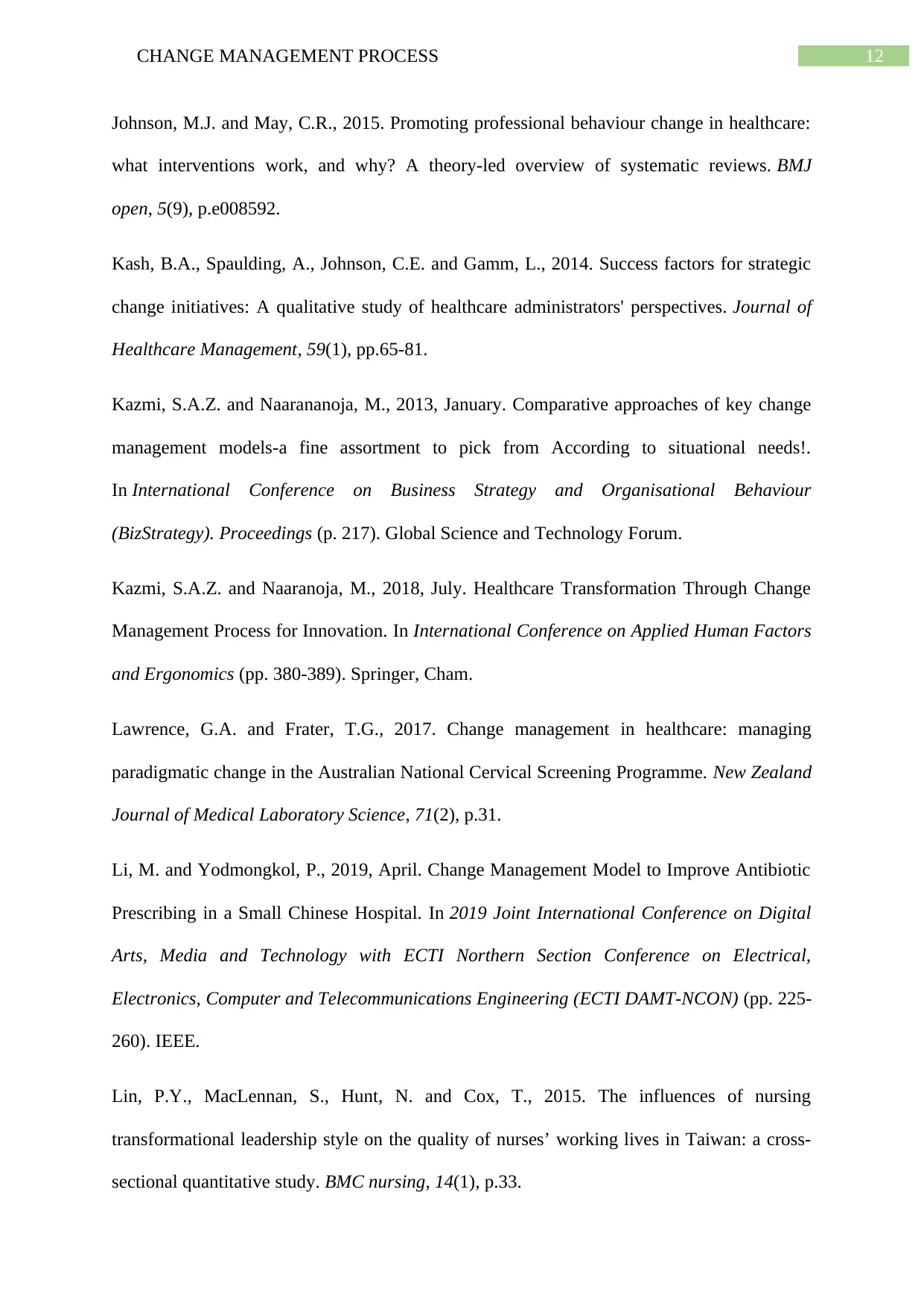
12CHANGE MANAGEMENT PROCESS
Johnson, M.J. and May, C.R., 2015. Promoting professional behaviour change in healthcare:
what interventions work, and why? A theory-led overview of systematic reviews. BMJ
open, 5(9), p.e008592.
Kash, B.A., Spaulding, A., Johnson, C.E. and Gamm, L., 2014. Success factors for strategic
change initiatives: A qualitative study of healthcare administrators' perspectives. Journal of
Healthcare Management, 59(1), pp.65-81.
Kazmi, S.A.Z. and Naarananoja, M., 2013, January. Comparative approaches of key change
management models-a fine assortment to pick from According to situational needs!.
In International Conference on Business Strategy and Organisational Behaviour
(BizStrategy). Proceedings (p. 217). Global Science and Technology Forum.
Kazmi, S.A.Z. and Naaranoja, M., 2018, July. Healthcare Transformation Through Change
Management Process for Innovation. In International Conference on Applied Human Factors
and Ergonomics (pp. 380-389). Springer, Cham.
Lawrence, G.A. and Frater, T.G., 2017. Change management in healthcare: managing
paradigmatic change in the Australian National Cervical Screening Programme. New Zealand
Journal of Medical Laboratory Science, 71(2), p.31.
Li, M. and Yodmongkol, P., 2019, April. Change Management Model to Improve Antibiotic
Prescribing in a Small Chinese Hospital. In 2019 Joint International Conference on Digital
Arts, Media and Technology with ECTI Northern Section Conference on Electrical,
Electronics, Computer and Telecommunications Engineering (ECTI DAMT-NCON) (pp. 225-
260). IEEE.
Lin, P.Y., MacLennan, S., Hunt, N. and Cox, T., 2015. The influences of nursing
transformational leadership style on the quality of nurses’ working lives in Taiwan: a cross-
sectional quantitative study. BMC nursing, 14(1), p.33.
Johnson, M.J. and May, C.R., 2015. Promoting professional behaviour change in healthcare:
what interventions work, and why? A theory-led overview of systematic reviews. BMJ
open, 5(9), p.e008592.
Kash, B.A., Spaulding, A., Johnson, C.E. and Gamm, L., 2014. Success factors for strategic
change initiatives: A qualitative study of healthcare administrators' perspectives. Journal of
Healthcare Management, 59(1), pp.65-81.
Kazmi, S.A.Z. and Naarananoja, M., 2013, January. Comparative approaches of key change
management models-a fine assortment to pick from According to situational needs!.
In International Conference on Business Strategy and Organisational Behaviour
(BizStrategy). Proceedings (p. 217). Global Science and Technology Forum.
Kazmi, S.A.Z. and Naaranoja, M., 2018, July. Healthcare Transformation Through Change
Management Process for Innovation. In International Conference on Applied Human Factors
and Ergonomics (pp. 380-389). Springer, Cham.
Lawrence, G.A. and Frater, T.G., 2017. Change management in healthcare: managing
paradigmatic change in the Australian National Cervical Screening Programme. New Zealand
Journal of Medical Laboratory Science, 71(2), p.31.
Li, M. and Yodmongkol, P., 2019, April. Change Management Model to Improve Antibiotic
Prescribing in a Small Chinese Hospital. In 2019 Joint International Conference on Digital
Arts, Media and Technology with ECTI Northern Section Conference on Electrical,
Electronics, Computer and Telecommunications Engineering (ECTI DAMT-NCON) (pp. 225-
260). IEEE.
Lin, P.Y., MacLennan, S., Hunt, N. and Cox, T., 2015. The influences of nursing
transformational leadership style on the quality of nurses’ working lives in Taiwan: a cross-
sectional quantitative study. BMC nursing, 14(1), p.33.
Paraphrase This Document
Need a fresh take? Get an instant paraphrase of this document with our AI Paraphraser
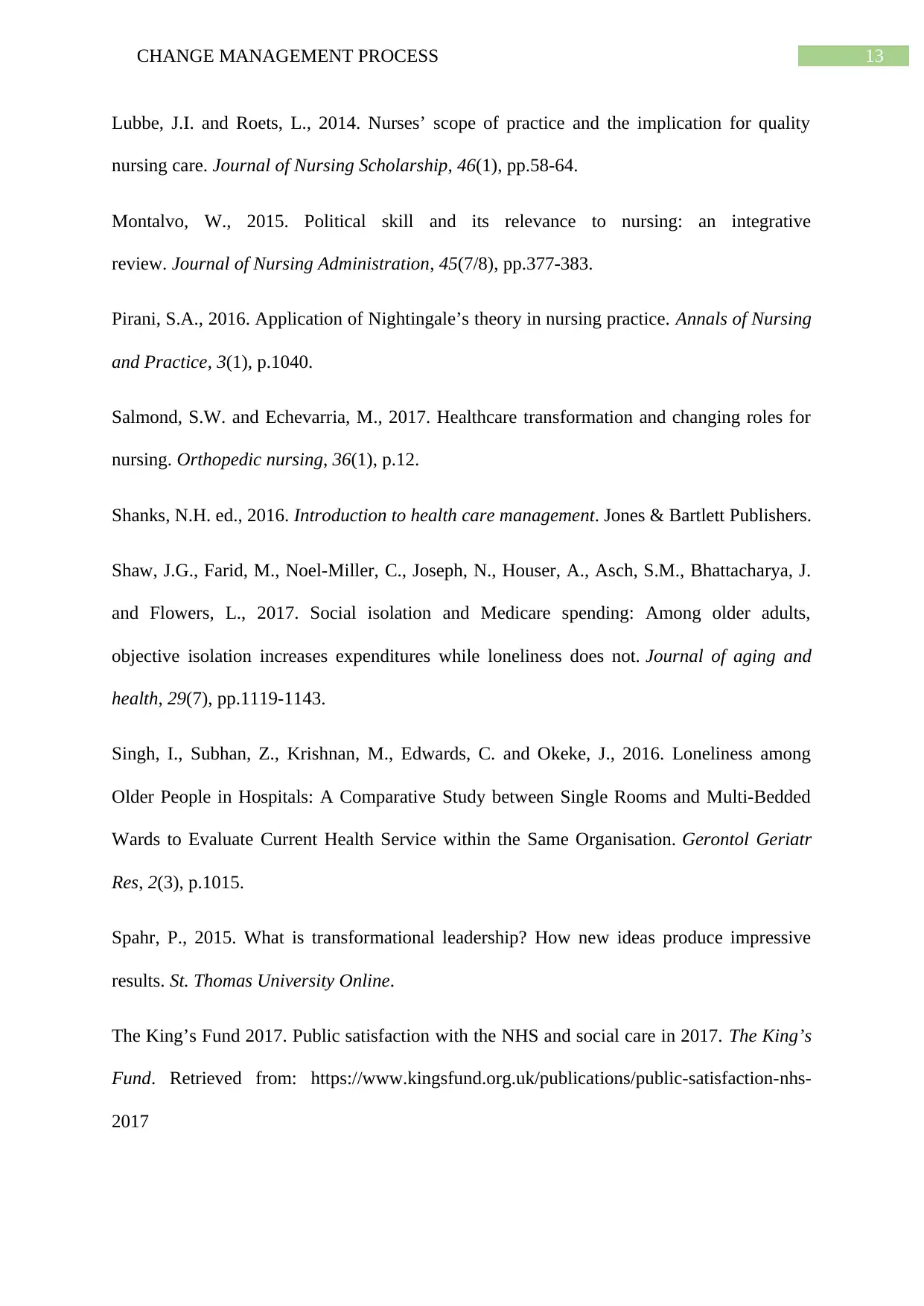
13CHANGE MANAGEMENT PROCESS
Lubbe, J.I. and Roets, L., 2014. Nurses’ scope of practice and the implication for quality
nursing care. Journal of Nursing Scholarship, 46(1), pp.58-64.
Montalvo, W., 2015. Political skill and its relevance to nursing: an integrative
review. Journal of Nursing Administration, 45(7/8), pp.377-383.
Pirani, S.A., 2016. Application of Nightingale’s theory in nursing practice. Annals of Nursing
and Practice, 3(1), p.1040.
Salmond, S.W. and Echevarria, M., 2017. Healthcare transformation and changing roles for
nursing. Orthopedic nursing, 36(1), p.12.
Shanks, N.H. ed., 2016. Introduction to health care management. Jones & Bartlett Publishers.
Shaw, J.G., Farid, M., Noel-Miller, C., Joseph, N., Houser, A., Asch, S.M., Bhattacharya, J.
and Flowers, L., 2017. Social isolation and Medicare spending: Among older adults,
objective isolation increases expenditures while loneliness does not. Journal of aging and
health, 29(7), pp.1119-1143.
Singh, I., Subhan, Z., Krishnan, M., Edwards, C. and Okeke, J., 2016. Loneliness among
Older People in Hospitals: A Comparative Study between Single Rooms and Multi-Bedded
Wards to Evaluate Current Health Service within the Same Organisation. Gerontol Geriatr
Res, 2(3), p.1015.
Spahr, P., 2015. What is transformational leadership? How new ideas produce impressive
results. St. Thomas University Online.
The King’s Fund 2017. Public satisfaction with the NHS and social care in 2017. The King’s
Fund. Retrieved from: https://www.kingsfund.org.uk/publications/public-satisfaction-nhs-
2017
Lubbe, J.I. and Roets, L., 2014. Nurses’ scope of practice and the implication for quality
nursing care. Journal of Nursing Scholarship, 46(1), pp.58-64.
Montalvo, W., 2015. Political skill and its relevance to nursing: an integrative
review. Journal of Nursing Administration, 45(7/8), pp.377-383.
Pirani, S.A., 2016. Application of Nightingale’s theory in nursing practice. Annals of Nursing
and Practice, 3(1), p.1040.
Salmond, S.W. and Echevarria, M., 2017. Healthcare transformation and changing roles for
nursing. Orthopedic nursing, 36(1), p.12.
Shanks, N.H. ed., 2016. Introduction to health care management. Jones & Bartlett Publishers.
Shaw, J.G., Farid, M., Noel-Miller, C., Joseph, N., Houser, A., Asch, S.M., Bhattacharya, J.
and Flowers, L., 2017. Social isolation and Medicare spending: Among older adults,
objective isolation increases expenditures while loneliness does not. Journal of aging and
health, 29(7), pp.1119-1143.
Singh, I., Subhan, Z., Krishnan, M., Edwards, C. and Okeke, J., 2016. Loneliness among
Older People in Hospitals: A Comparative Study between Single Rooms and Multi-Bedded
Wards to Evaluate Current Health Service within the Same Organisation. Gerontol Geriatr
Res, 2(3), p.1015.
Spahr, P., 2015. What is transformational leadership? How new ideas produce impressive
results. St. Thomas University Online.
The King’s Fund 2017. Public satisfaction with the NHS and social care in 2017. The King’s
Fund. Retrieved from: https://www.kingsfund.org.uk/publications/public-satisfaction-nhs-
2017
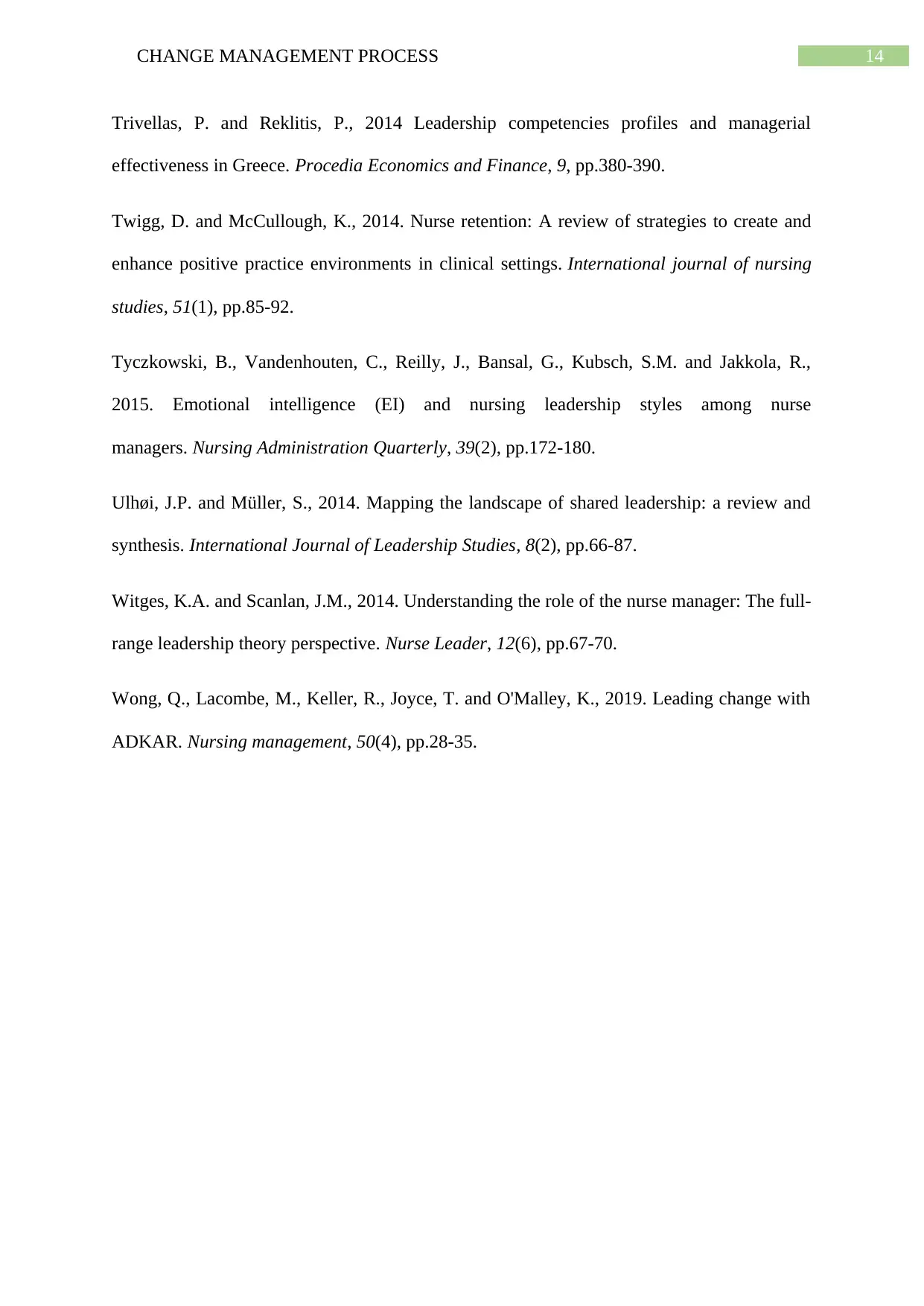
14CHANGE MANAGEMENT PROCESS
Trivellas, P. and Reklitis, P., 2014 Leadership competencies profiles and managerial
effectiveness in Greece. Procedia Economics and Finance, 9, pp.380-390.
Twigg, D. and McCullough, K., 2014. Nurse retention: A review of strategies to create and
enhance positive practice environments in clinical settings. International journal of nursing
studies, 51(1), pp.85-92.
Tyczkowski, B., Vandenhouten, C., Reilly, J., Bansal, G., Kubsch, S.M. and Jakkola, R.,
2015. Emotional intelligence (EI) and nursing leadership styles among nurse
managers. Nursing Administration Quarterly, 39(2), pp.172-180.
Ulhøi, J.P. and Müller, S., 2014. Mapping the landscape of shared leadership: a review and
synthesis. International Journal of Leadership Studies, 8(2), pp.66-87.
Witges, K.A. and Scanlan, J.M., 2014. Understanding the role of the nurse manager: The full-
range leadership theory perspective. Nurse Leader, 12(6), pp.67-70.
Wong, Q., Lacombe, M., Keller, R., Joyce, T. and O'Malley, K., 2019. Leading change with
ADKAR. Nursing management, 50(4), pp.28-35.
Trivellas, P. and Reklitis, P., 2014 Leadership competencies profiles and managerial
effectiveness in Greece. Procedia Economics and Finance, 9, pp.380-390.
Twigg, D. and McCullough, K., 2014. Nurse retention: A review of strategies to create and
enhance positive practice environments in clinical settings. International journal of nursing
studies, 51(1), pp.85-92.
Tyczkowski, B., Vandenhouten, C., Reilly, J., Bansal, G., Kubsch, S.M. and Jakkola, R.,
2015. Emotional intelligence (EI) and nursing leadership styles among nurse
managers. Nursing Administration Quarterly, 39(2), pp.172-180.
Ulhøi, J.P. and Müller, S., 2014. Mapping the landscape of shared leadership: a review and
synthesis. International Journal of Leadership Studies, 8(2), pp.66-87.
Witges, K.A. and Scanlan, J.M., 2014. Understanding the role of the nurse manager: The full-
range leadership theory perspective. Nurse Leader, 12(6), pp.67-70.
Wong, Q., Lacombe, M., Keller, R., Joyce, T. and O'Malley, K., 2019. Leading change with
ADKAR. Nursing management, 50(4), pp.28-35.
1 out of 15
Related Documents
Your All-in-One AI-Powered Toolkit for Academic Success.
+13062052269
info@desklib.com
Available 24*7 on WhatsApp / Email
![[object Object]](/_next/static/media/star-bottom.7253800d.svg)
Unlock your academic potential
© 2024 | Zucol Services PVT LTD | All rights reserved.




